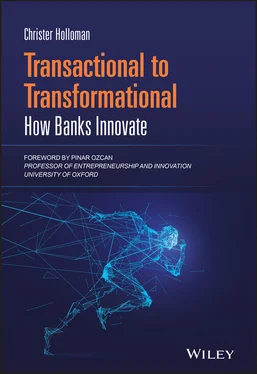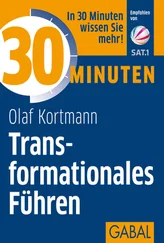In order to oversee the implementation of all these steps and to provide additional senior stakeholder sponsorship, they would create a Corporate Venture Panel (CVP). These sponsors included a senior colleague from each of the RICE areas, along with senior colleagues from enabling areas such as Group Legal and the Chief Technology Office. The panel would initially meet on a quarterly basis to oversee the pan‐Group activity, review partnering decisioning and consider investment rationale.
‘We are not an asset manager, not here to choose the next Klarna, we invest in partners that can help transform our business. When you have an equity stake sponsored by a business unit, rather than a separate investment vehicle, the synergies become more entrenched.’
Carla Antunes da Silva, Group Strategy Director
The mobilisation of the innovation working groups provided a more accurate view of the existing activity levels in each part of the organisation. They found that each area had different strengths and gaps relative to the planned baseline. For example, in some areas they were conducting a lot of market scanning but they were struggling to get momentum behind proper engagements; other areas had excellent momentum behind a limited number of high‐profile opportunities, but without the depth of opportunity to ensure sustainable delivery. A tailored development plan was therefore put in place for each area and the central team's support focus was also phased.
Notably, in some areas, the initial market assessments raised more fundamental questions about their innovation priorities. It also took some time to embed the target partner decision framework into the bottom‐up work to ensure that the highest potential opportunities were being surfaced. There was also a broader task around building awareness of the partnering opportunity across relevant product and transformation teams. As such, while the opportunity engine had been switching on, there was some lag before it started to generate the desired level of pipeline activity.
The second thing that became apparent is that the friction involved in partner engagement and experiments was creating a bottleneck in the pipeline. Whilst some drop‐off was expected between the identify/assess and engage stage, the actual conversion level was below expectations. Qualitative feedback from colleagues also highlighted the time and complexity involved in delivering at this stage. It was also recognised that excessive friction at this point in the process also has the potential to negatively impact the experience for the fintech, for example, by adding additional cost to their side of the partnering activity. The central fintech team has taken ownership of driving forward improvements in this journey by working with relevant process owners to right‐size or simplify processes. In addition, they believe that the group's existing technology transformation journey will support a growing number of partnerships over the next one to two years, for example, by improving the availability of APIs to support integration.
Nonetheless, they were able to leverage the early successes to maintain momentum and visibility. For example, case studies and articles were written up and shared with all colleagues via the group's main interchange site. Similarly, the senior sponsorship from the CVP helped to maintain the focus and drive.
As they built up their experience and pooled the learnings across the group, they were able to sharpen their priority spaces and their supporting frameworks. For example, they saw two clusters begin to show the most potential. The first of these was centred on partnering to accelerate or enhance their capabilities in strategically important emerging technologies. The second cluster centred on partnerships that would allow them to extend their customer offering into relevant adjacencies where partnering provided an advantage to developing the adjacent capabilities internally, for example, due to economies of scale or required speed‐to‐market.
Crucially, their early pathfinder opportunities allowed them to socialise at Executive and Board level as well as via their Corporate Venture Panel. This enabled them to begin to hone their approach to partnership structuring. They had already established that they only planned to make investments where they were confident of a long‐term partnering relationship with the fintech. Their intention was then to understand the incremental benefit of pairing the commercial partnering relationship with strategic equity investment.
One of their pathfinder projects in this space was their relationship with Thought Machine.
Since 2017, Lloyds had been completing extensive testing and proofs of concept with Thought Machine's Vault capability, a cloud‐native next generation banking platform. They anticipated that the new technology could enable Lloyds to provide customers with more tailored products, as well as enable faster development cycles and further digital banking improvements. In this scenario they found that there were sufficient benefits in making a strategic investment in Thought Machine above and beyond their contractual agreement. For example:
Accelerating outcomes. It would help to fund the development of the core product, enabling swifter product delivery into Lloyds.
Demonstrating organisational commitment. It would signal an enhanced level of organisation commitment to the partnership, supporting deeper collaboration.
Financial upside. Whilst not the primary driver, they believed that Thought Machine was well aligned to future industry technology trends and that their partnership would support the company's growth. The investment allowed them to participate in this future valuation upside.
As a result, the Group's Corporate Development team began to engage on a potential equity investment. In recent years, the team has conducted a number of sizeable acquisitions or disposals of large loan portfolios. Therefore, the consideration of this opportunity provided a very new set of challenges. The team had to adapt in terms of:
Valuation method. Future revenue growth was a much more significant component on the valuation model versus the typical balance sheet approach.
Due diligence. Technical due diligence and IP are significant parts of the process relative to the traditional credit review.
Risk analysis. They had to identify and accept a different blend of risks given the relative age of the company and the stage of product development.
Working closely with the team at Thought Machine, the team adapted to this new type of transaction and Lloyds invested £11 million for a c.10% stake in 2018 as part of the company's Series A round.
The RICE innovation working groups are now all mobilised and are generating a more robust pipeline of opportunities. Since late 2018, when the new structured approach to fintech partnering was introduced, the Group has identified c.2,000 fintechs against 130 specified business needs. A further c.50 opportunities are currently in the engage phase.
Over the course of eight quarterly CVPs, 70 material opportunities have been presented. This has resulted in nine live partnerships and three equity investments. In addition to those that have been supported via CVP, four others have been originated.
Their ability to measure this aggregate pipeline including the performance by stage is itself the result of the successful deployment of their fintech tooling. Moreover, their ability to highlight the challenges of third‐party experimentation both quantitatively and qualitatively has increased the collective will to make improvements to their journey.
Perhaps most promisingly, the two thematic opportunity clusters that have emerged have begun to influence strategic planning. They began the activity aiming to respond to the strategic demands of the business areas but now that there is greater visibility of the opportunities that can be opened up through investing, some areas are re‐calibrating. For example, they are considering the way they implement and maintain technologies or what business models they might pursue in the future.
Читать дальше











